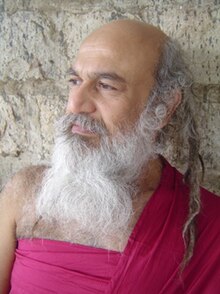
Kundalini yoga derives from kundalini, defined in tantra as energy that lies within the body, frequently at the navel or the base of the spine. In normative tantric systems, kundalini is considered to be dormant until it is activated and channeled upward through the central channel in a process of spiritual perfection. Other schools, such as Kashmir Shaivism, teach that there are multiple kundalini energies in different parts of the body which are active and do not require awakening. Kundalini is believed by adherents to be power associated with the divine feminine, Shakti. Kundalini yoga as a school of yoga is influenced by Shaktism and Tantra schools of Hinduism. It derives its name through a focus on awakening kundalini energy through regular practice of mantra, tantra, yantra, yoga, laya, haṭha, meditation, or even spontaneously (sahaja).
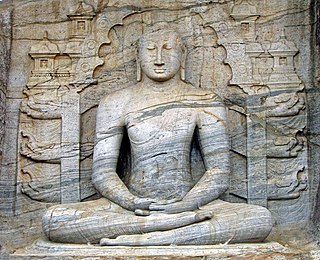
Samādhi, in Hinduism, Buddhism, Jainism, Sikhism and yogic schools, is a state of meditative consciousness. In many Indian religious traditions, the cultivation of Samādhi through various meditation methods is essential for the attainment of spiritual liberation.

Neem Karoli Baba or Neeb Karori Baba, also known to his followers as 'Maharaj-ji', was a Hindu guru and a devotee of the Hindu deity Hanuman. He is known outside India for being the spiritual master of a number of Americans who travelled to India in the 1960s and 1970s.

Nisargadatta Maharaj was an Indian guru of nondualism, belonging to the Inchagiri Sampradaya, a lineage of teachers from the Navnath Sampradaya.

Kriya Yoga is a yoga system which consists of a number of levels of pranayama, mantra, and mudra, intended to rapidly accelerate spiritual development and engender a profound state of tranquility and God-communion. It is described by its practitioners as an ancient yoga system revived in modern times by Lahiri Mahasaya, who claimed to be initiated by a guru, Mahavatar Babaji, circa 1861 in the Himalayas. Kriya Yoga was brought to international awareness by Paramahansa Yogananda's book Autobiography of a Yogi and through Yogananda's introductions of the practice to the West from 1920.

Amrit Desai is a pioneer of yoga in the West, and one of the few remaining living yoga gurus who originally brought over the authentic teachings of yoga in the early 1960s. He is the creator of two brands of yoga, Kripalu Yoga and I AM Yoga, and is the founder of five yoga and health centers in the US. His yoga training programs have reached more than 40 countries worldwide and over 8,000 teachers have been certified.

Siddharudha Swami is an Indian Hindu guru and philosopher.
Shri Amrit Nath Ashram is an ashram of the Nath Sampradaya of MannaNathi Panth founded by Shri Amritnathji Maharaj in a small town of Fatehpur in region of Shekhawati which comes in Sikar district of Rajasthan, India. The region of Shekhawati is renowned for its artwork and beautiful havelis. The area is also very rich in wildlife, particularly birds, with different varieties of parrots, peacocks, white eagles, nilkanths and other exotic species.

Dhyāna in Hinduism means meditation and contemplation. Dhyana is taken up in Yoga practices, and is a means to samadhi and self-knowledge.
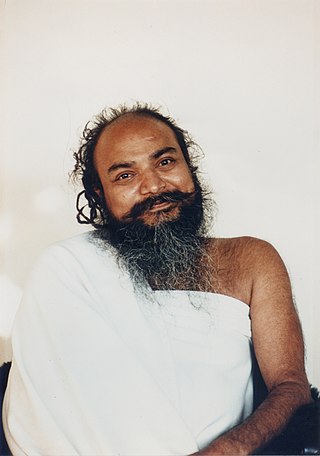
Shri Shivabalayogi Maharaj was a yogi who claimed to have attained self-realization through twelve years of arduous tapas, meditating in samādhi for an average of twenty hours a day.
Swami Maheshwarananda, born Mangilal Garg, known as Swamiji, is a yogi, guru.
Adhyatma Niketan is an ashram in Gwalior, Madhya Pradesh, India. It is situated on Koteshwar Road, Near Vinay Nagar sector-1, is around 7 km from the Gwalior Railway station.

Jangama dhyana is a meditation technique which has been practiced by various sages over the centuries. In recent times, this technique was widely taught in India and around the world by Shri Shivabalayogi Maharaj, who claimed to have experienced a spiritual vision in which the manifestation of a Jangama sage instructed him in this technique of meditation to achieve self-realization. Jangama means 'eternal existence' and dhyana means 'meditation.' Hence Jangama dhyana is 'Meditation on the Eternal Existence .'
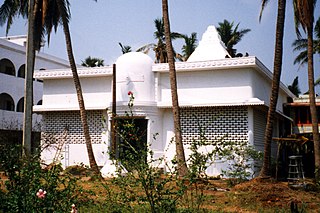
Adivarapupeta is a village in the East Godavari district of the Indian state of Andhra Pradesh. Shivabalayogi was born in the village and did twelve years of meditation. His mahasamadhi was done in his Ashram at the village.
Bhava Samadhi is a state of ecstatic consciousness that can sometimes be a seemingly spontaneous experience, but is recognized generally to be the culmination of long periods of devotional practices. It is believed by some groups to be evoked through the presence of "higher beings." "Bhava" means "feeling", "emotion", "mood", "mental attitude" or "devotional state of mind." "Samadhi" is a state of consciousness in which the mind becomes completely still and the consciousness of the experiencing subject becomes one with the experienced object. Thus, "bhava samadhi" denotes an advanced spiritual state in which the emotions of the mind are channelled into one-pointed concentration and the practitioner experiences devotional ecstasy. Bhava samadhi has been experienced by notable figures in Indian spiritual history, including Sri Ramakrishna Paramahamsa and some of his disciples, Chaitanya Mahaprabhu and his chief associate Nityananda, Mirabai, Kundalini Guru Shri Anandi Ma, and numerous saints in the bhakti tradition.

Swami Nigamananda Paramahansa was an Indian yogi, guru and mystic in Eastern India. He is associated with the Shakta tradition and a spiritual master of vedanta, tantra, yoga and prema or bhakti. His followers referred him as Thakura.
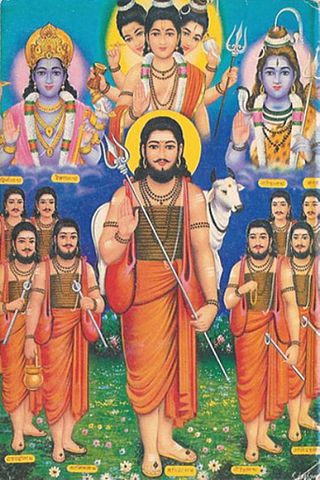
The Inchagiri Sampradaya, also known as Nimbargi Sampradaya, is a lineage of Hindu Navnath and Lingayat teachers from Maharashtra and Karnataka, which was started by Bhausaheb Maharaj. It is inspired by Sant Mat teachers as Namdev, Raidas and Kabir. The Inchagiri Sampradaya has become well known throughout the western world due to the popularity of Nisargadatta Maharaj.

Shri Swami Keshwanand Satyarthi Ji Maharaj was an Indian guru of Shri Nangli Sahib lineage. The spiritual institution Paramhans Satyarthi Mission was led and governed by him. In 1985, Shri Paramhans Swami Ramanand Satyarthi Ji Maharaj anointed him as his spiritual successor and the patron saint of the Paramhans Satyarthi Mission. Swami Keshwanand Satyarthi Ji Maharaj travelled around the world and preached about spirituality and enlightenment. Swami Ramanand Satyarthi Trust, Shri Satyarthi High School, Shri Satyarthi Sevadal and Shri Satyarthi Sandesh Magazine were also administered under his guidance.

Ashtanga yoga is Patanjali's classification of classical yoga, as set out in his Yoga Sutras. He defined the eight limbs as yamas (abstinences), niyama (observances), asana (posture), pranayama (breathing), pratyahara (withdrawal), dharana (concentration), dhyana (meditation) and samadhi (absorption).
